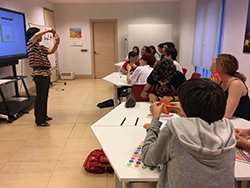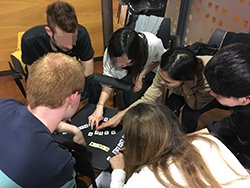Unstoppable and Fast Growing! –Japanese-Language Education in Spain–Required Support Moving Forward
The Japan Foundation, Madrid
SUZUKI Hiroka
Though Japanese-language education began in Spain later than in other Western European countries, the recent spread of the Internet has led to increased interest in Japanese culture, resulting in a sudden rise in the number of Japanese-language educational institutions, teachers, and learners. According to the Survey on Japanese-Language Education Abroad 2018, Spain now has the 4th highest number of learners in Western Europe, surpassing Italy. The Japan Foundation, Madrid (hereinafter “JFMD”) runs a variety of Japanese language programs, but in this report, I will focus on our support for Japanese-language learners to demonstrate the current momentum behind Japanese-language education in Spain.
(1) The Japanese-Language Courses Based on the JF Standard for Japanese-Language Education (Hereinafter “JFS”)
The Japanese-language courses in JFMD were launched as a pilot Japanese-language course based on a trial version of “Marugoto: Japanese Language and Culture” (hereinafter “Marugoto”) in 2011, one year after the JFMD was opened. Since that time, the JFMD has collaborated with the Association of Teachers of Japanese in Spain (APJE), which was also founded in 2010, to spread the use of Marugoto and ensure learners could study effectively, such as by creating the “Marugoto Grammar Manual” (Marugoto Gramática) and Kanji Practice Booklet, and Spanish versions of supplementary teaching materials available for download on the Marugoto website. The number of courses offered grow each year according to demand, reaching a total of approximately 60 courses in AY2019, including those offered at the partner schools Casa Asia Madrid and Casa Asia Barcelona, with nearly 400 students learning Japanese. These students have a variety of reasons for learning Japanese, but the most common reason is a like for or an interest in Japanese culture, followed by a desire to travel to Japan.
(2) Support for Learners in Secondary Education
One group that cannot be forgotten when discussing Japanese learners in Spain are those at the secondary school level (hereinafter “secondary school students”). While Japanese has not yet been introduced in public education, many secondary school students study Japanese at third party schools or with private teachers, showing a rising need for support at that level. Accordingly, the JFMD offers “Japanese-language for Secondary School Students” twice per year to meet that demand. The Can-do goal of the course is to be able to speak about one’s self to a certain extent, and the course incorporates online resources and cultural experience activities to allow students to learn the basics of the Japanese language while having fun. However, there are currently no subsequent courses for these students to continue in once they have completed the course. A future challenge will be to offer a course that will allow those students to continue studying after completing the starter course.

A class from the “Japanese-Language for Secondary School Students.”
(3) Support for Intermediate and Advanced Learners
The rise in Japanese learners has led to a rise in those wishing to continue their studies after completing the Intermediate level. While courses up to Intermediate level are easy to find in Spain, it becomes a challenge to find courses beyond that level. Therefore, the JFMD offers an “Intermediate to Advanced B1/B2 Courses” for students who have completed the “Marugoto Intermediate 2 Course” and wish to continue studying. Meanwhile, while there are higher educational institutions like universities offering Japanese-language education at the undergraduate level, it is not yet available at the graduate level. One reason for this is that even if one majors in Japanese at higher educational institutions, it is not easy to find appropriate work in the field after graduation. My hope is that Japanese language positions, such as teaching positions, will increase in the future, including in the realm of public education. Accordingly, the JFMD will likely be expected to contribute to support for the establishment of curriculums enabling students to study the Japanese language for those jobs, and to help raise non-native teachers for those curriculums.
(4) Support for Regional Learners
While the majority of learners and schools are overwhelmingly located in Madrid and Catalonia, the rising interest in studying Japanese in other regions, such as Andalusia and Valencia, is also worthy of note. For that reason, the JFMD is putting effort into the deployment of JF Japanese e-learning Minato (hereinafter “Minato”), a Japanese-language learning platform, to provide learners in these other regions with more opportunities to learn Japanese. We currently run the Marugoto Tutor Support Course for A1-1 and A1-2 levels, as well as an original course called “Survival Japanese-Travel Edition” in both self-study and tutor supported format. Many learners register for these each time they are held. We also hold gatherings for a conversation club called “¡Vamos a Nihonguear!” (hereinafter “Nihonguear”) six times per year at which Japanese-language learners and native speakers can deepen their exchange by having conversations in Japanese according to set themes and playing games together. We have also held special editions of the event several times in areas outside Madrid in order to enable learners in other regions to have the opportunity to interact with native speakers and other learners. These special events included Malaga and Barcelona in AY2019, as well as one in Lisbon, Portugal to commemorate the 160th anniversary of friendship between Japan and Portugal. In each case, the participants always offer feedback that they hope we continue to hold these events from now on. Moving forward, I feel that the JFMD must continue to provide support so that ultimately, each region will be able to continue holding the Nihonguear events independently.

The special edition of Nihonguear hold in Barcelona
With the State of Emergency declaration issued in March 2020 due to the Covid-19 Pandemic, the JFMD has been called on to rapidly shift Japanese learners’ support to online venues. We are currently adopting and promoting new types of Japanese programs that leverage the strengths of those online venues, and the Japanese-language team will continue to provide Japanese learning support in order to reach a wider range of learners.
- What We Do Top
- Arts and Cultural Exchange [Culture]
- Japanese-Language Education Overseas [Language]
- Japanese-Language Education Overseas [Language] Top
- Learn Japanese-language
- Teach Japanese-language
- Take Japanese-Language Test
- Know about Japanese-language education abroad
- The Japanese-Language Institute, Urawa
- The Japanese-Language Institute, Kansai
- Japanese-Language Programs for Foreign Specified Skilled Worker Candidates
- Japanese Language Education for Japanese Children Resident Overseas and for the Descendants of Migrants
- Archives
- Japanese Studies and Global Partnerships [Dialogue]
- JF digital collection
- Other Programs / Programs to Commemorate Exchange Year
- Awards and Prizes
- Publications
